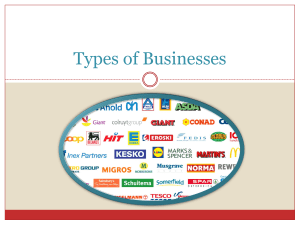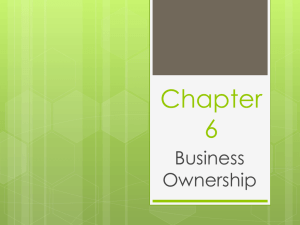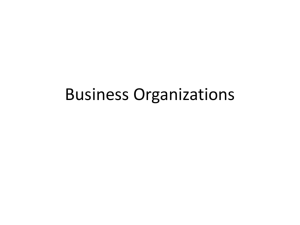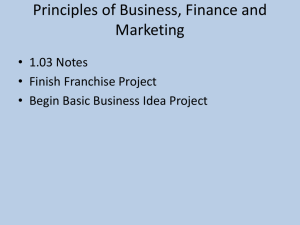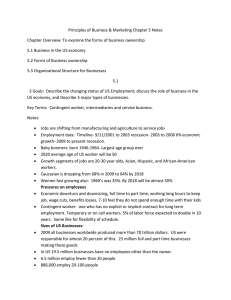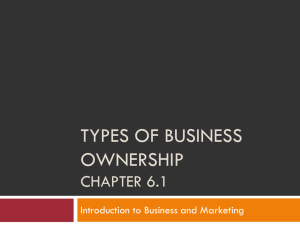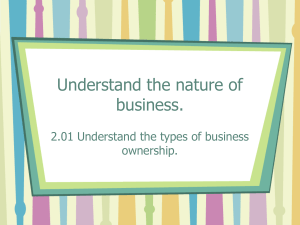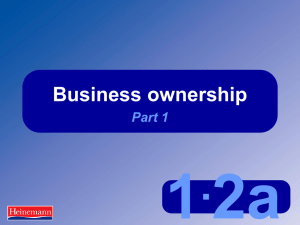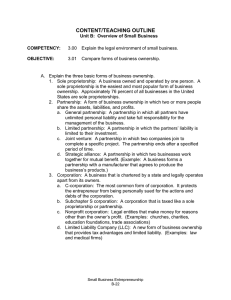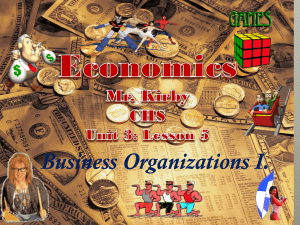Specific Objectives
advertisement
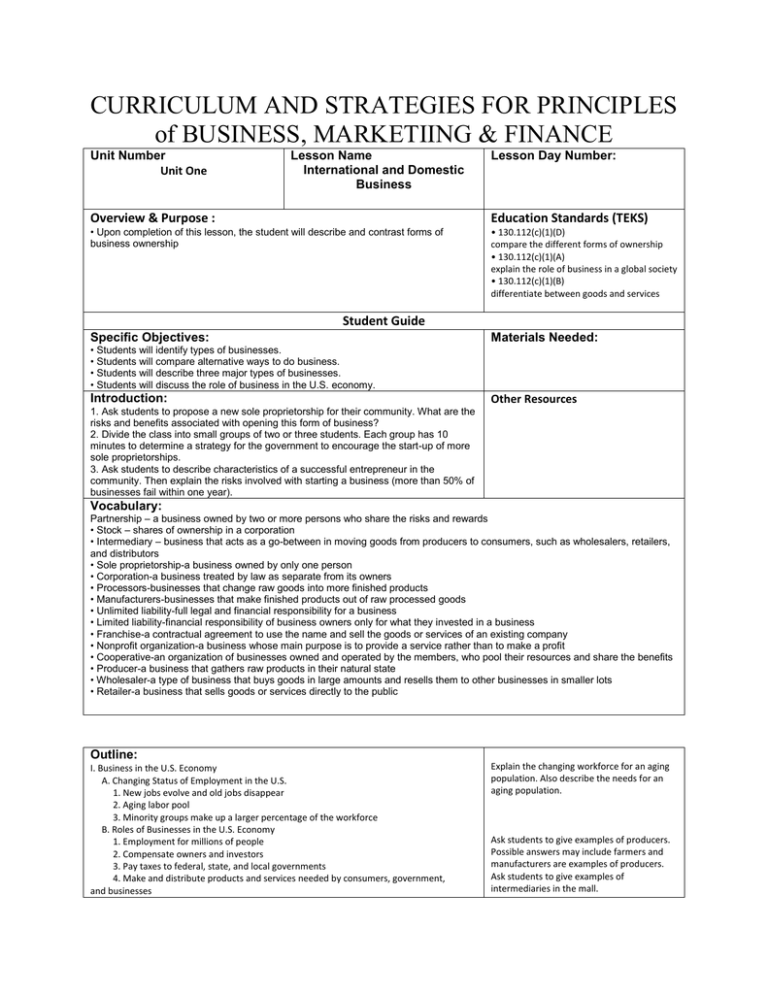
CURRICULUM AND STRATEGIES FOR PRINCIPLES of BUSINESS, MARKETIING & FINANCE Unit Number Unit One Lesson Name International and Domestic Business Lesson Day Number: Overview & Purpose : Education Standards (TEKS) • Upon completion of this lesson, the student will describe and contrast forms of business ownership • 130.112(c)(1)(D) compare the different forms of ownership • 130.112(c)(1)(A) explain the role of business in a global society • 130.112(c)(1)(B) differentiate between goods and services Student Guide Specific Objectives: Materials Needed: • Students will identify types of businesses. • Students will compare alternative ways to do business. • Students will describe three major types of businesses. • Students will discuss the role of business in the U.S. economy. Introduction: Other Resources 1. Ask students to propose a new sole proprietorship for their community. What are the risks and benefits associated with opening this form of business? 2. Divide the class into small groups of two or three students. Each group has 10 minutes to determine a strategy for the government to encourage the start-up of more sole proprietorships. 3. Ask students to describe characteristics of a successful entrepreneur in the community. Then explain the risks involved with starting a business (more than 50% of businesses fail within one year). Vocabulary: Partnership – a business owned by two or more persons who share the risks and rewards • Stock – shares of ownership in a corporation • Intermediary – business that acts as a go-between in moving goods from producers to consumers, such as wholesalers, retailers, and distributors • Sole proprietorship-a business owned by only one person • Corporation-a business treated by law as separate from its owners • Processors-businesses that change raw goods into more finished products • Manufacturers-businesses that make finished products out of raw processed goods • Unlimited liability-full legal and financial responsibility for a business • Limited liability-financial responsibility of business owners only for what they invested in a business • Franchise-a contractual agreement to use the name and sell the goods or services of an existing company • Nonprofit organization-a business whose main purpose is to provide a service rather than to make a profit • Cooperative-an organization of businesses owned and operated by the members, who pool their resources and share the benefits • Producer-a business that gathers raw products in their natural state • Wholesaler-a type of business that buys goods in large amounts and resells them to other businesses in smaller lots • Retailer-a business that sells goods or services directly to the public Outline: I. Business in the U.S. Economy A. Changing Status of Employment in the U.S. 1. New jobs evolve and old jobs disappear 2. Aging labor pool 3. Minority groups make up a larger percentage of the workforce B. Roles of Businesses in the U.S. Economy 1. Employment for millions of people 2. Compensate owners and investors 3. Pay taxes to federal, state, and local governments 4. Make and distribute products and services needed by consumers, government, and businesses Explain the changing workforce for an aging population. Also describe the needs for an aging population. Ask students to give examples of producers. Possible answers may include farmers and manufacturers are examples of producers. Ask students to give examples of intermediaries in the mall. C. Three Major Categories of Businesses 1. Producers-create products and services used by individuals and other businesses 2. Intermediaries-sell goods and services 3. Service businesses-carries out activities that are consumed by its customers II. Forms of Business Ownership A. Sole Proprietorships-owned and run by one person 1. For individuals who want to work and make decisions independently 2. Little government regulation 3. Great risk for the owner B. Partnership-owned and controlled by two or more people 1. People who share an idea for a business 2. People who want to cooperate in managing and investing, and want to share the risks and rewards of the business C. Corporation-separate legal entity owned by one or more shareholders and managed by a board of directors 1. More difficult to form 2. Subject to more regulations 3. Limited liability for investors III. Other Forms of Ownership A. Limited Liability Partnership B. Joint Venture C. S-Corporation D. Limited Liability Company E. Nonprofit Corporation F. Cooperative G. Franchise Then ask students to give examples of service businesses that they use. Examples of service businesses might include Internet service providers, doctors, dentists, hair stylists, and lawn care specialists. Ask students to list a business that they would feel comfortable operating as a sole proprietor. Then ask students to explain why they are qualified. Ask students to list the risks involved with partnerships. Explain how partners have unlimited liability in the partnership. Ask students to list three corporations that they think are good investment choices. Then have the students look up the stock performance for their choices. Describe how a limited liability partnership would allow you to begin a partnership with a noted expert who is only liable for the amount they invested in the company. Explain how a joint venture ends when a project is completed. Ask students to give examples of franchises. Fast food restaurants, hotels, and other businesses operate as franchises. Looking Forward: Q: What is one advantage of investing in a corporation? A: One advantage is limited liability. Q: What is the size of the workforce for the greatest number of businesses in the U.S? A: The greatest number of businesses in the U.S. employs less than 20 people. Q: Which form of business ownership is the most complex and difficult to form? A: The most complex form of business ownership is the corporation. Q: What are disadvantages of the partnership form of business? A: Disadvantages include unlimited liability, uncertain life, and disputes among the partners. FORMING A FRANCHISE Students will explain the process for operating a specific franchise. Information will be presented in a PowerPoint presentation. The presentation must give concrete steps to apply for and operate the franchise. A rubric will be used to evaluate this project.
